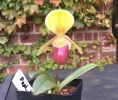|
|
|
|
|
| |
Flasks of
Paphiopedilum helenae 'Rick' × 'Eric' |
|
| |
|
|
| |
|
|
Click to Enlarge

Pod Parent Flower |
Click to Enlarge

Pollen Parent |
|
|
|
| |
For additional origin/habitat information supplied courtesy of
Charles and Margaret Baker, see further below, near the bottom of this page.
|
Temperatures we attempt to use in the lab & greenhouse:
| For Species: |
|
Spring, Summer, Autumn: days average 83°F, nights 68°F; best fit is Warm-Intermediate 87-64°F
(Source:
Baker's Web OSC) |
| For Species: |
|
Winter: days average 60°F, nights 44°F; best fit is Cool-Cold 64-44°F
(Source:
Baker's Web OSC) |
|
About the name...
| Etymology of |
helenae |
|
Named for Mrs. Helena Averyanova.
(Source:
Braem & Bakers) |
| Etymology of |
Paphiopedilum |
|
From Greek "Paphia" the name of Aphrodite of Cypress; "pedilon", sandal.
(Source:
Pridgeon 1992) |
| Pronunciation of |
Paphiopedilum |
|
paf-ee-oh-PED-i-lum
(Source:
Pridgeon 1992) |
|
If you would like to direct someone to this web page, please copy and paste this URL into your email:
http://troymeyers.com/d?017768
| Ordering Information |
| You are not currently logged in. |
|
You must be a registered user and be logged in to reserve a flask or place a notification request. Please log in:
|
|
|
|
|
|
| |
The origin/habitat information below is supplied courtesy of Charles and Margaret Baker
The following information is based on the name of the plant provided by the donor, and assumes that the name is correct. If the plant has been misidentified, then the following information may not be correct.
This text is copyrighted by the Bakers and may not be reproduced without permission.
ORIGIN/HABITAT: Vietnam. Paphiopedilum helenae is found near Cao Bang in
the extreme northeastern part of the country. This is a region of ancient,
greatly eroded limestone ridges and mesas crowded in a relatively flat
alluvial valley. These ridges and mesas have relatively vertical slopes
and stand 350-500 ft. (100-150 m) above the valley floor. Depressions in
the valley formed by numerous sinks in the underlying limestone formations
usually fill with water during the rainy season resulting in numerous
small or medium-sized lakes between the limestone ridges. These karst
lakes sometimes disappear near the end of the dry season, but they do
serve as a moisture source which provides additional humidity to the
region during the dry season.
Paphiopedilum helenae grows in close association with forests of
Keteleeria davidiana, a member of the Pine family distributed primarily in
southern China. Plants are mostly found on lightly shaded or open ledges
with a northern exposure. They grow just above vertical bluffs at
2800-2950 ft. (850-900 m) and are usually found on small, narrow shelves
and in rocky crevices, often at the base of small trees and shrubs. It is
not unusual, however, to find plants growing on the vertical limestone
cliffs in areas with no cracks in the rocks but with the plant roots
closely attached to the more or less smooth rock surface.
More about this information and the Bakers...
|
|
|
| |
|
|
|